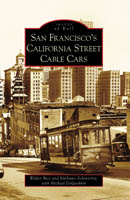Foot of Market’s Future
John King, the Chronicle’s excellent urban design writer, is taking a look at the “re-imagining” going on about the public space surrounding San Francisco’s most famous transit shrine: the old Ferry Building streetcar loop.
John King, the Chronicle’s excellent urban design writer, is taking a look at the “re-imagining” going on about the public space surrounding San Francisco’s most famous transit shrine: the old Ferry Building streetcar loop.
Few cities in the world have shown as much loyalty to a single streetcar design as has Melbourne. The “W” class of trams was introduced in 1923, with a design that was the opposite of the “California” type streetcar common on this side of the Pacific.
Hamburg’s tramway system, like those of many German cities, was devastated by World War II.
 Nothing evokes vanished San Francisco more than the old California Street Cable Railroad Company, more familiarly known as “Cal Cable.” This private company, founded by Leland Stanford, operated cable cars from 1878 to 1951, when it went bankrupt and was taken over by Muni. After that, politicians effectively dismembered it, and we’re still talking about whether its remnants can be improved.
Nothing evokes vanished San Francisco more than the old California Street Cable Railroad Company, more familiarly known as “Cal Cable.” This private company, founded by Leland Stanford, operated cable cars from 1878 to 1951, when it went bankrupt and was taken over by Muni. After that, politicians effectively dismembered it, and we’re still talking about whether its remnants can be improved.
This car commemorates Philadelphia Suburban Transportation Co. (PST)–the ‘Red Arrow’ lines serving Philly’s western suburbs–which ran interurban cars with some PCC features from 1949 to 1982.
This streetcar is painted to honor Dallas, which ran PCCs from 1945 to 1956.
This car is painted in tribute to the ‘Magic Carpets’, as Muni’s first five modern-design streetcars were known.
This streetcar is painted to honor Market Street Railway Company, Muni’s private competitor from 1921 to 1944 and the namesake of our nonprofit organization.
This car is painted to honor Illinois Terminal Railroad System (ITS), which once ran an extensive interurban passenger service in southern Illinois.